
Dominic Armato

Audio By Carbonatix
Once upon a time, back in the early 21st century, I got into an argument about sushi.
I was singing the virtues of a dinner near Tokyo’s Tsukiji fish market when our antagonist – we’ll call him Mr. Snootypants – expressed horror and revulsion that my family would deign to sit at a table and order with a ticket and pencil rather than eating at the bar. Sushi, he explained, is a higher art form; not just a meal prepared by a skilled craftsman, but a complex and sacred performance where the interaction between diner and itamae is critical to the experience.
I get it, I told him, I’ve no less respect for the craft than you, but awkwardly sitting four abreast isn’t exactly a family-friendly night out. Yes, ordering off a ticket is a more casual and less artful experience, but it absolutely has its place. And besides, we’re talking about a well-regarded Japanese restaurant in Japan. Are you saying they don’t know how to appreciate their own food?
Mr. Snootypants responded with heated, righteous indignation. Ordering sushi off a ticket was a travesty. It was contrary to sushi’s “original intent.” It was “fast food sushi.”
It’s interesting you say so, I told him, because back in the Edo period when nigiri sushi evolved into the format we know today, it was primarily sold by street vendors from small stalls and carts – a quick, inexpensive convenience food to eat and go about your day. Fast food, I gleefully informed him, was precisely sushi’s “original intent.”
At this, Mr. Snootypants harumphed and trundled off, and I basked in the smug satisfaction that while I sometimes get a little snobby about food, at least I’m not that guy.
Two decades later, Kura Revolving Sushi Bar’s arrival in Phoenix has forced me to consider the possibility that maybe I am.
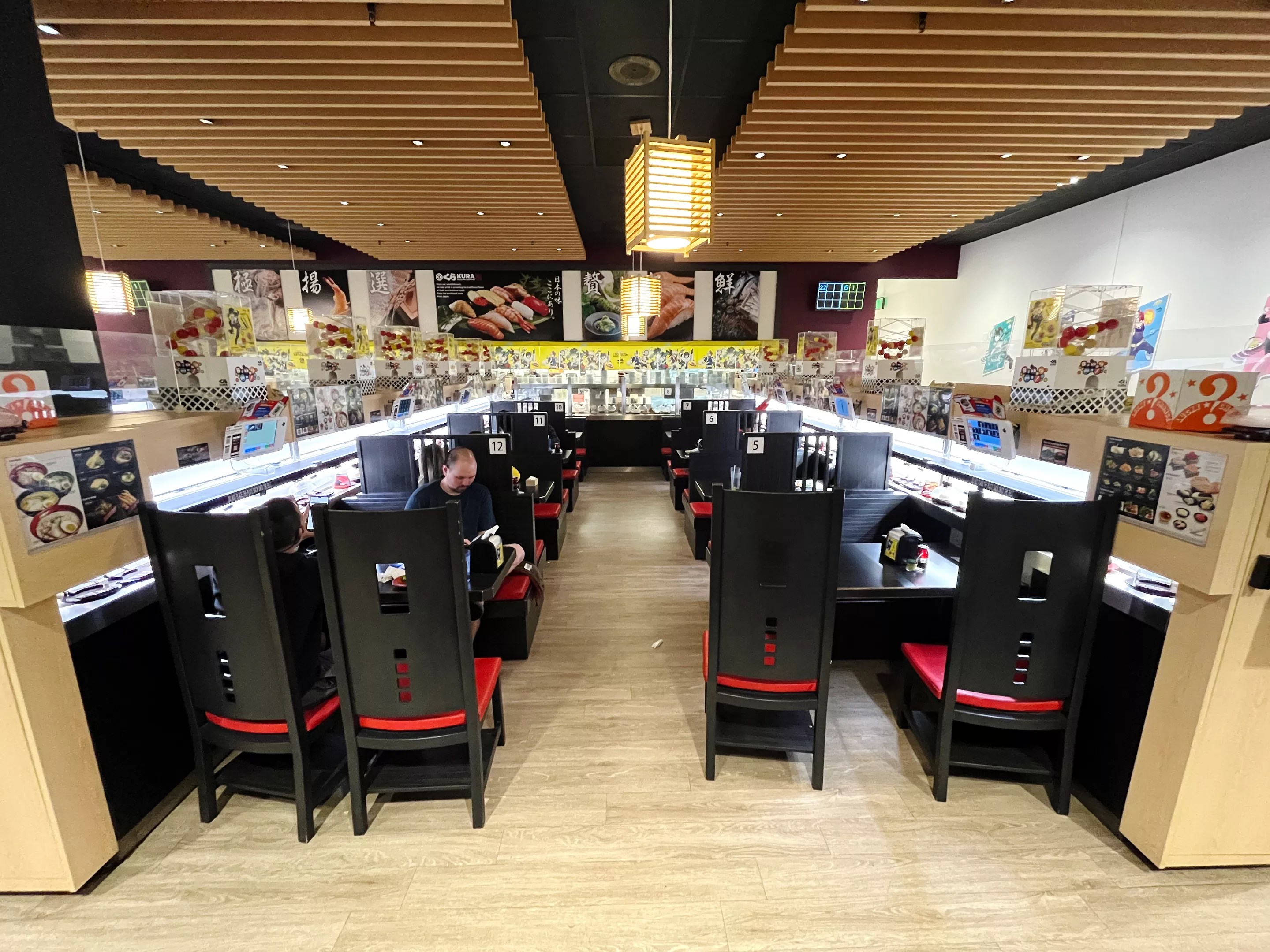
Tables at Kura are arranged to maximize access to the conveyor belt.
Dominic Armato
Dinner or Dystopia
Kura, you see, is a breed of restaurant called kaitenzushi, or as you likely know it, conveyor belt sushi. It might be tempting to assume that this impersonal, cut-rate format is an American invention, a bit of cultural sacrilege wrapped around an ancient tradition with mechanical, capitalistic precision. But kaitenzushi was conceived and remains wildly popular in Japan, where Kura is a titan of the genre, boasting nearly 500 locations in the motherland alone.
Hey, people in Japan like fast food, too. But “fast food” barely begins to describe the experience, which makes a pencil and ticket seem charmingly quaint.
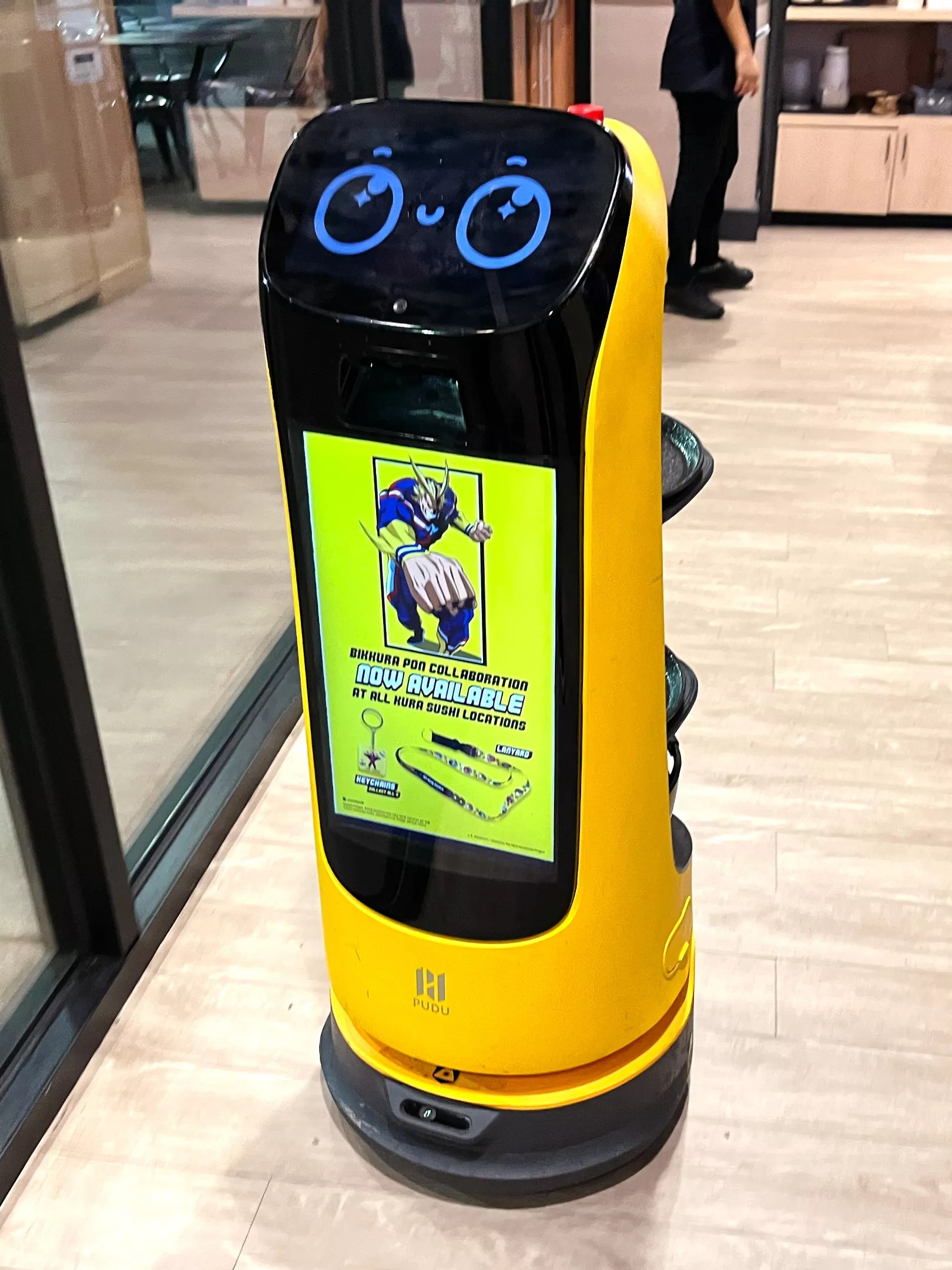
A robot with a cute animated face and a British accent delivers drinks to your table.
Dominic Armato
Kura is the (un)holy union of a sushi bar and a pachinko parlor – a flashing, pulsating, electrified, and amplified dose of sensory overload where the food is practically a sideshow. Once you’re seated and place an order on your tableside touchscreen menu, a Hobbit-sized robot with cartoonish facial animations and an incongruous British accent pulls up to deliver your drink.
Meanwhile, sushi selections slowly drift by on brightly colored plates, each protected from the heat – and, hopefully, other diners – by “Mr. Fresh,” a hinged plastic dome that yawns like Pac-Man and belches forth your chosen vittles when you lift up the edge.
Don’t see what you want on the belt? No problem. Return to the touchscreen menu, and a few minutes later your dish arrives, heralded by 8-bit musical fanfare and delivered via a special express conveyor belt that whisks it directly from the kitchen to your table.
There’s no service to speak of, unless you specifically call for it (via touchscreen, natch). But a human responds if you order alcohol. The robot is underage.
Who clears the plates? You do. Finish one off and drop it in the tableside chute, where it disappears into Kura’s bowels with a clatter and thunk before it’s digested and tallied on your digital screen. Every five plates, your touchscreen displays an anime short featuring Mutenmaru, the restaurant’s mascot, who urges you to help him fight off the evil creatures stealing his recipes by sending him more plates. And every 20 plates, you receive manna from heaven when an overhead dispenser delivers gachapon – some manner of cheap, cartoonish trinket sealed inside a hollow plastic ball.
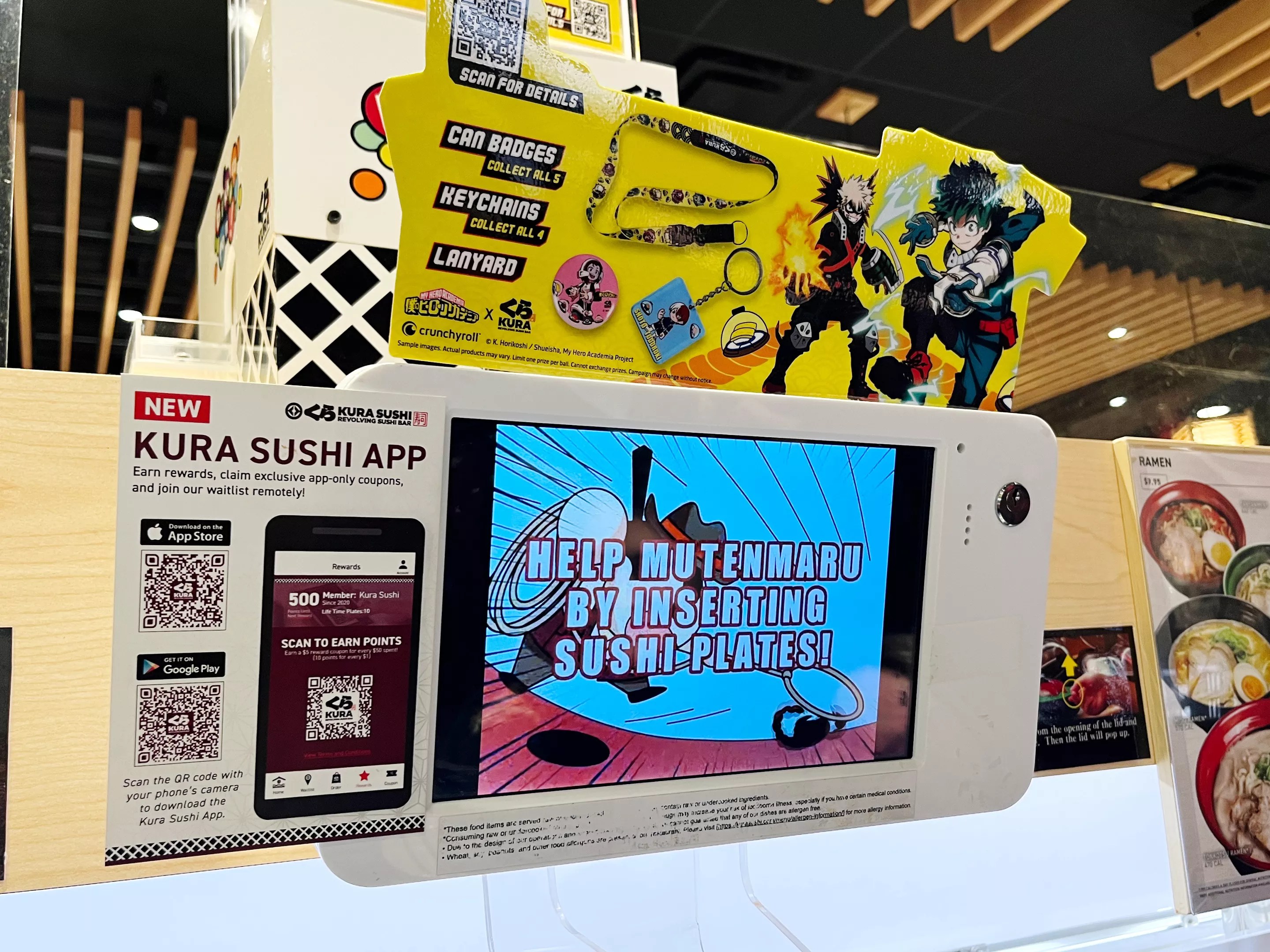
Mutenmaru, Kura’s mascot, urges you to give him more plates!
Dominic Armato
If automated, gamified dining sounds like some kind of future dystopia, you’re not far from the mark. The thing is, even for a culinary curmudgeon like me, it’s also kind of fun. That’s probably why there’s routinely an hour wait on the weekends, and why the original Biltmore location already has metastasized to Chandler.
What’s more, anyone who has traveled to the source will recognize Kura as quintessentially Japanese, right down to the soy sauce carafes that dispense a drop at a time – a perfectly typical Japanese model, built as though specifically designed to frustrate American diners who prefer to saturate their rice with a pint of the stuff.
Is Authentic Always Good?
Maybe that’s part of the appeal. When it comes to international restaurants, we’re all obsessed with “authenticity” these days. We want the “real” cuisine, not that fake garbage. And if the place is packed with people who speak the language – like the group of ladies standing outside one recent evening – that’s just a sign you’re on the right track. After all, if it’s good enough for Japan, it should be good enough for us.
But is that true?
Honoring culture and tradition is a noble exercise and an important one. But the “people from that country eat there so it must be good” trope conveniently ignores the fact that folks all over the world visit restaurants for all kinds of reasons having nothing to do with food quality.
Plus, everyone in Japan knows what traditional sushi is like, but does everyone in Japan have good taste in sushi? Anyone who thinks America has cornered the market in schlocky stunt food has clearly never visited Japan.
We stand aghast when someone uses the wrong type of miso in a bowl of ramen. Meanwhile, in Tokyo, they’re dunking soft serve ice cream, cones and all, into theirs. And lest anyone suggest that a sushi chain in Japan wouldn’t be so popular if it wasn’t great, I’ll point out that the biggest, most successful hamburger restaurant in the U.S. is McDonald’s.
So, is Kura authentic? Heck yeah, it is. But is it good? About that …
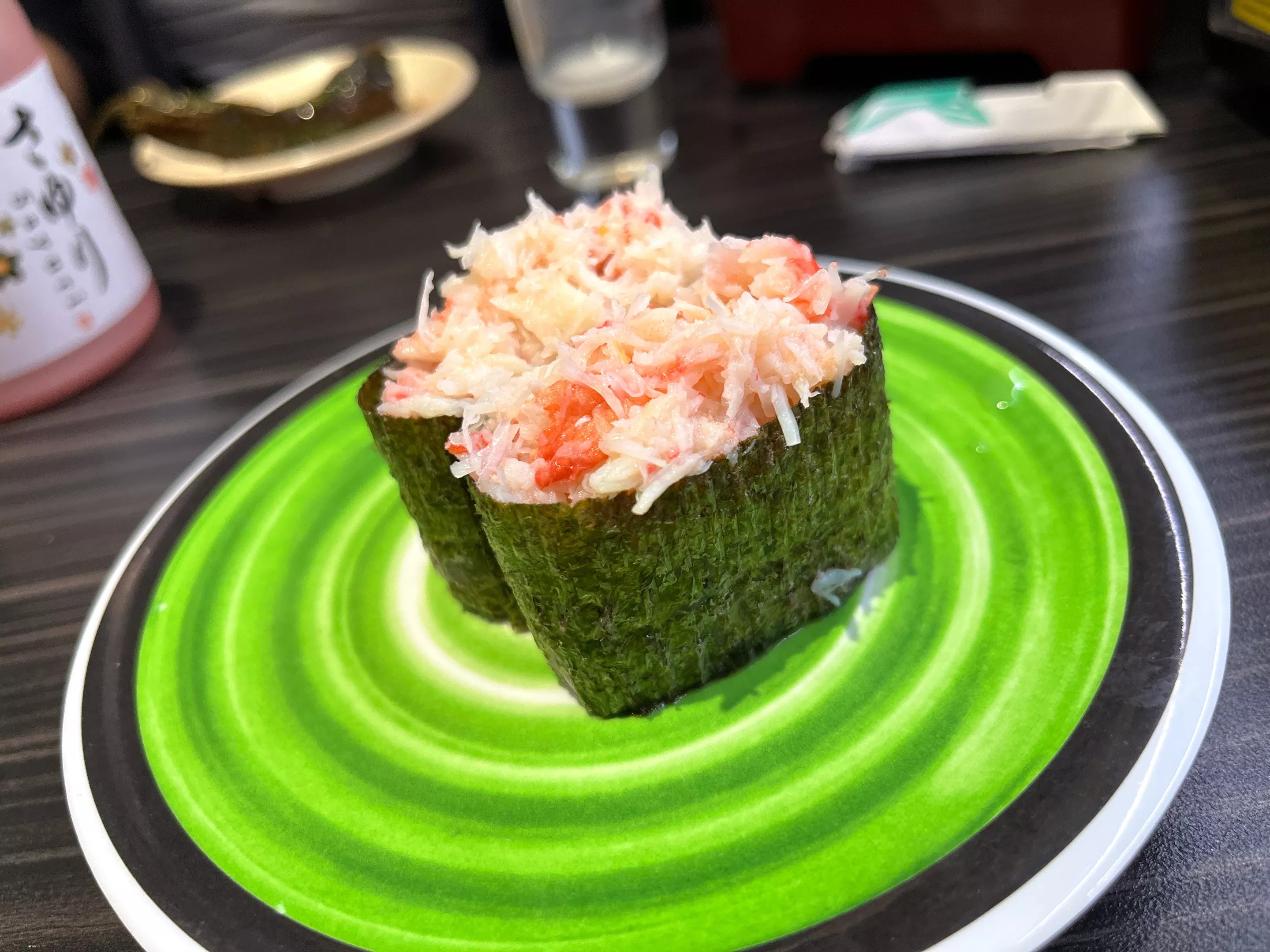
Kura uses real crab, but the fake stuff would probably taste better.
Dominic Armato
Mechanical Delivery, Deplorable Sushi
Take a simple slice of tuna atop a finger of sushi rice. At Kura, the rice’s texture leans towards amalgamated mush, but credit where it’s due: The flavor is nicely balanced, and you get a pronounced salty-sweet whiff of seasoned vinegar as it passes your lips. It’s better than the rice at the average Phoenix sushi joint, though that says more about the average Phoenix sushi joint than it does about Kura.
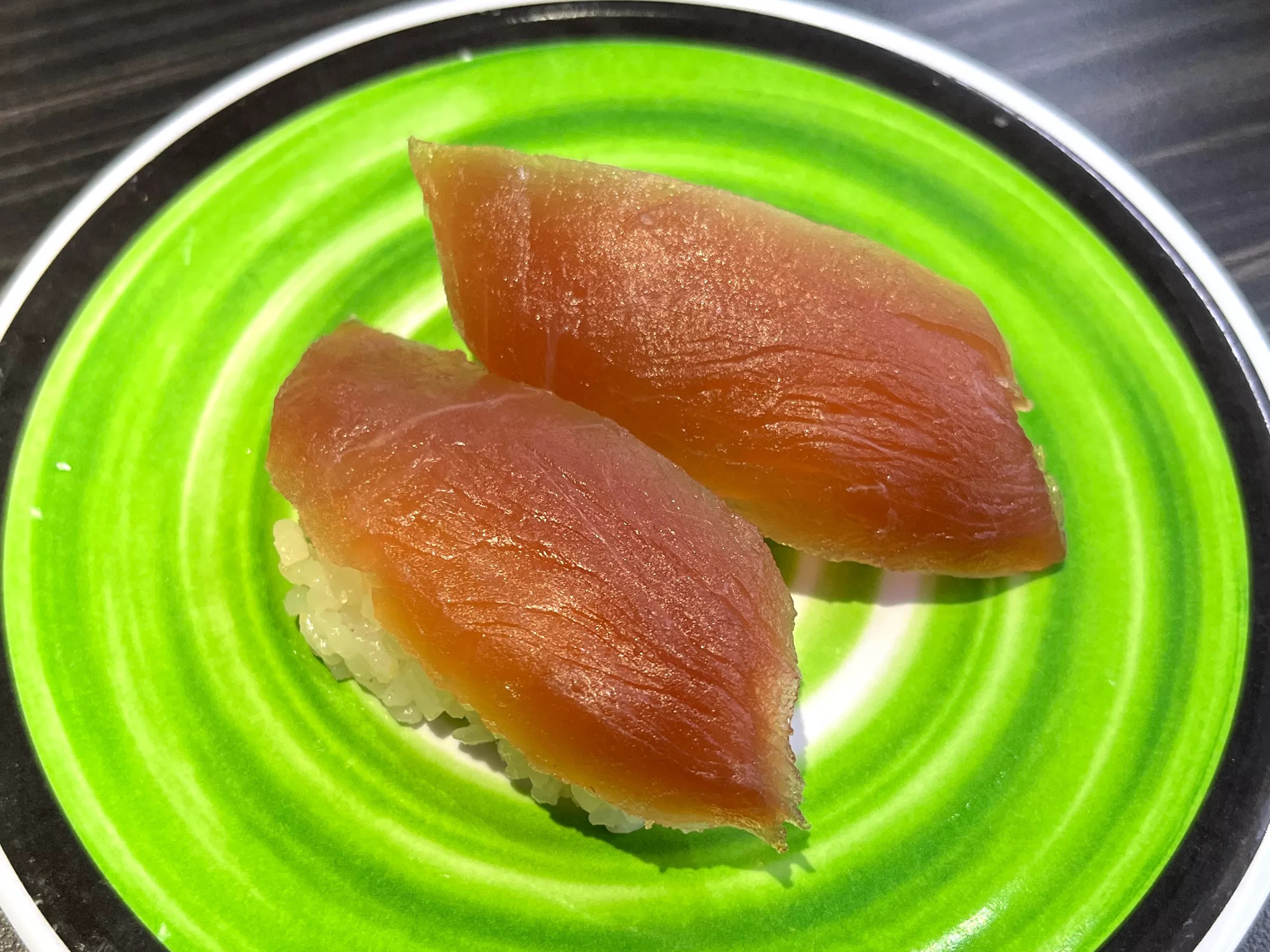
The tuna nigiri at Kura is about as good as it looks.
Dominic Armato
The tuna, however, is an entirely different matter. I appreciate that Kura doesn’t gas their tuna to produce a freakishly pink hue, but the fish’s dank, yellow-brown pallor almost makes me wish they did. It tastes about as vibrant as it looks.
The “real crab” gunkan – boat-shaped nigiri wrapped in nori – is filled with real crab, but honestly, I’d prefer the fake stuff. Kura’s finely minced mix is mostly flavorless, all kinds of watery, and salty enough that you might want to remove your rings before engaging. Sockeye salmon – defrosted yet somehow a “seasonal special” – is a similarly squishy bite that has more than enough flavors going on, none of which are good.
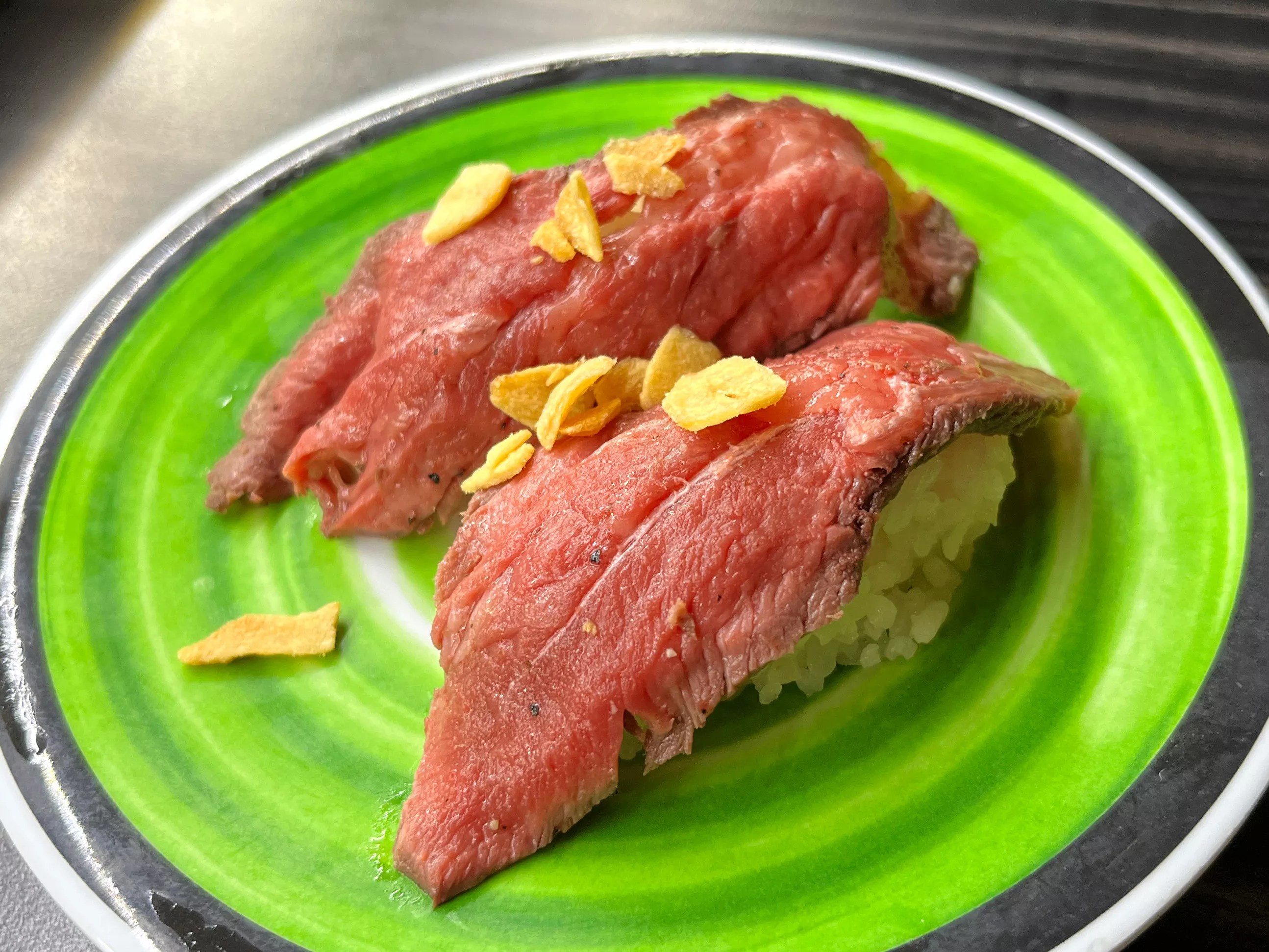
Beef nigiri at Kura is like a slab of tough, unseasoned deli roast beef.
Dominic Armato
You might think the negitoro is a safer bet – the rich and fatty bits of tuna trim minced down with a bit of fresh scallion bite. You might also be wrong. It has the consistency of toothpaste and appears to have been extruded in similar fashion.
Judging from the empty Mr. Freshes (Misters Fresh?), the beef sushi is quite popular, but I’m at a loss to understand why. The “premium American beef” is like a tough, unseasoned, ice-cold slab of deli roast beef smothering a smidgen of rice.
As a sushi fan who prefers minimal simplicity, it kills me to say that you’re probably better off with rolls. They aren’t particularly good, even by American sushi standards, but at least the sauces obscure the funk. I’d detail some for you, but honestly, they all taste pretty much the same. Just pick one. Maybe avoid the Texan roll. A friend tasted its sticky yuzu cream and dubbed it “Nope Sauce.”

Do not, under any circumstances, eat the uni.
Dominic Armato
Oh, the uni. I should have known better than to try the uni, but dear reader, this is the service I provide. I eat the uni at Kura Revolving Sushi Bar so you don’t have to. And you shouldn’t. Seriously, please don’t. Sea urchin roe is one of my favorite foods in the world, but these skanky, mustard gray lobes screamed with a foul acrid sharpness and the bitter aftertaste of chemical burn. The thought of all the people who tried uni for the first time at Kura and swore it off forever just breaks my heart.
As a grim coda, I spied a roll on the conveyor belt – removed and replaced by a diner, I suspect – that had slipped off the plate and become partially masticated by Mr. Fresh’s plexiglass maw. It stayed there all night, a mangled reminder of the evening’s carnage, passing us over and over again at precise 11-minute intervals.
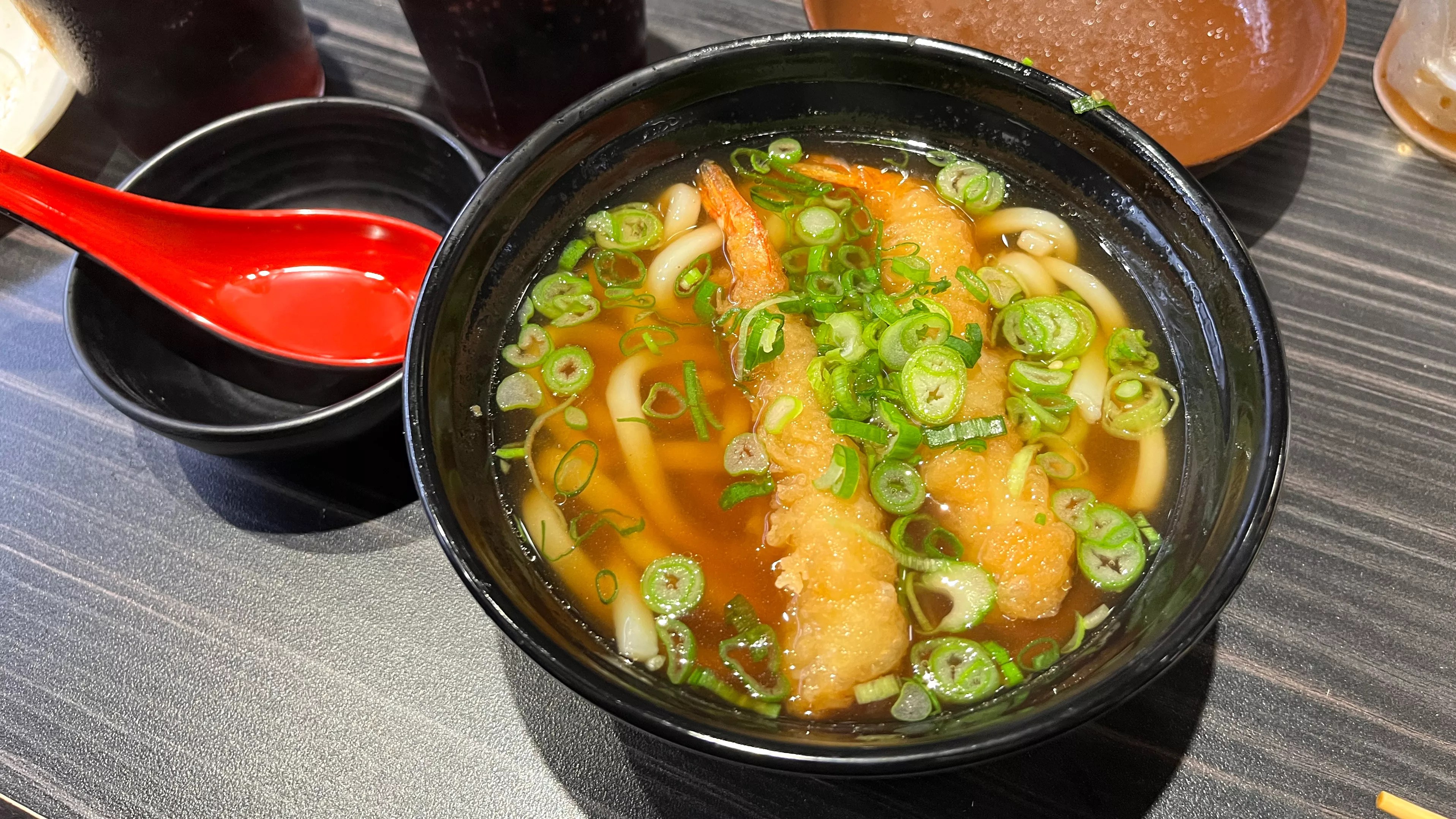
Simple udon in dashi is difficult to screw up, even for Kura.
Dominic Armato
Defensive Dining at Kura
Kura is pretty awful most of the time. Unfortunately, it’s also awfully fun, which means your friends, co-workers, and kids are going to drag you there. Heck, I’ll be back. My daughter loves the place. And it is possible to cobble together an inoffensive meal at Kura, if you are so inclined, but you have to be smart about it. I don’t recommend it. I don’t recommend any of this. But in a pinch, you can refer to Dom’s Guide to Defensive Ordering at Kura.
For nigiri, best to stick to the fatty fish or – I can’t believe I’m saying this – anything with mayo. A little bit goes a long way toward mellowing out those lean, raggedy cuts. Garlic ponzu sashimi is little more than the minced-up scraps left over from the nigiri, but drowning it in a bright sauce gives a little zip to otherwise flavorless protein. Eel is pretty safe, since that’s usually a packaged item anyway. Ditto inari sushi. And hand rolls ordered from the express belt at least guarantee that your meal hasn’t been circulating for three hours.
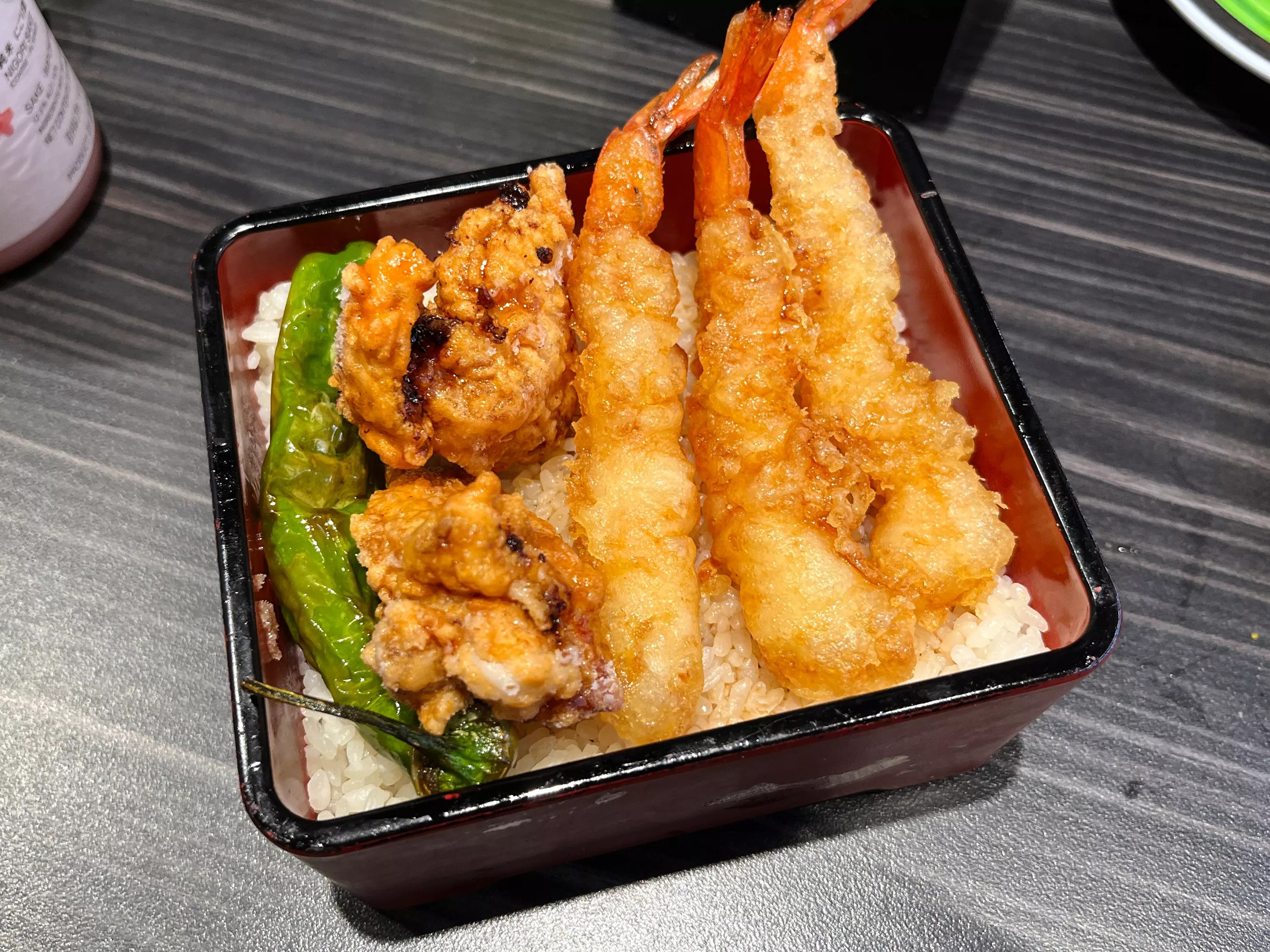
Ten Jyu — a tempura assortment dressed with a sweet sauce — is a good defensive order at Kura.
Dominic Armato
The beef ojyu – sukiyaki-esque simmered beef and onions served over rice – isn’t half bad. And the sweetly dressed ten jyu is a collection of tempura items that have a little crisp, sugary zip.
Ramen is overdone and oversalted, though the tantanmen version will do. Better is a bowl of shrimp tempura udon that’s clean and simple and hard to screw up. The shishito salmon skin was actually tasty – lightly fried slivers of skin with a good amount of meat attached, served with blistered fresh peppers. And the Japanese-style soy milk donuts make for a solid fried dough and ice cream dessert.
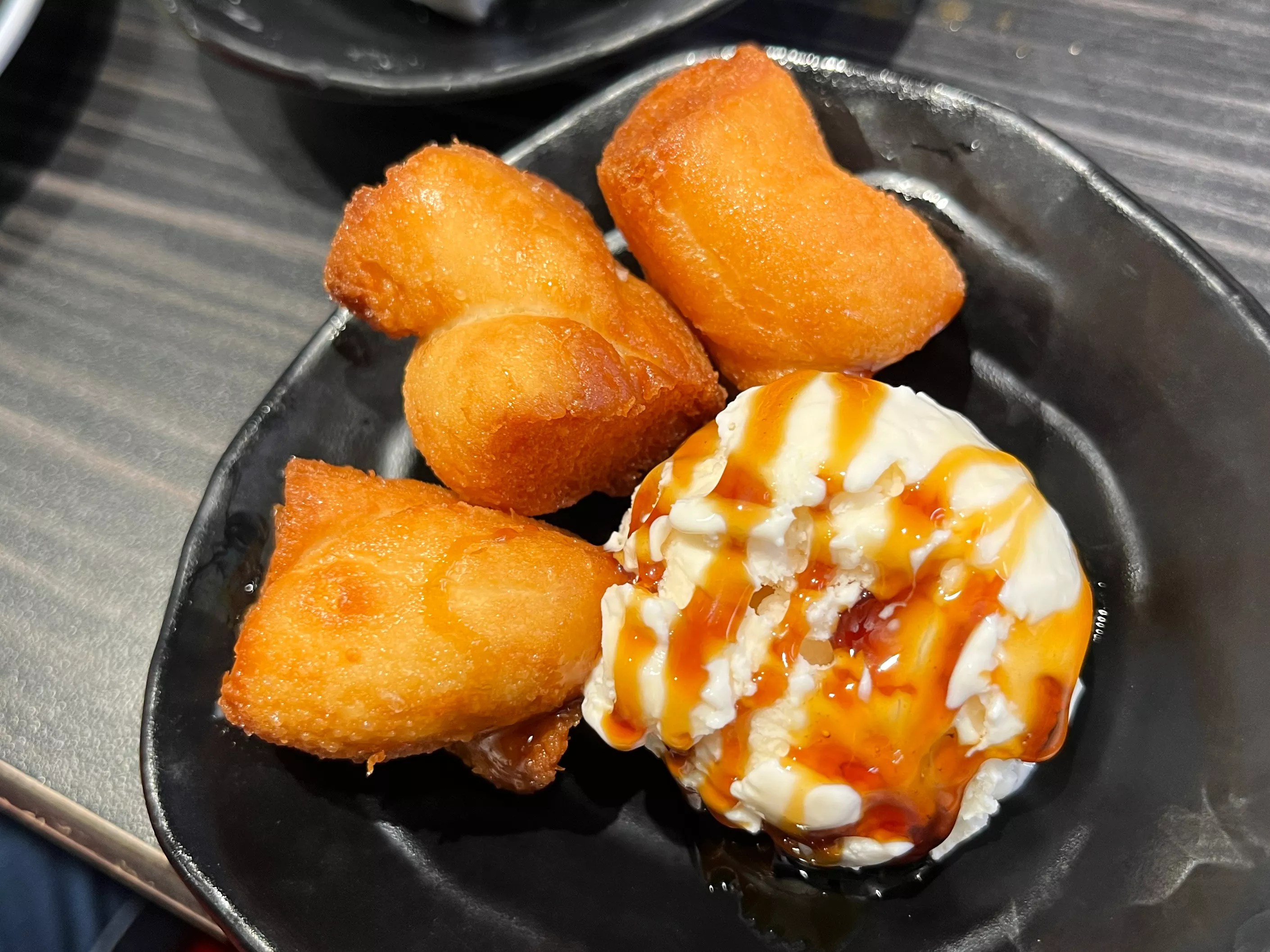
Crispy donut bites with vanilla ice cream are a nice dessert.
Dominic Armato
But these are the palatable exceptions to a mostly dismal collection that becomes all the more deflating when you stop to consider our dwindling seafood supply. The quality of the food is distressing enough, but watching its consumption so casually and carelessly mass-marketed and gamified inspires a particularly exquisite horror. If we’re going to fish bluefin tuna into extinction, can’t we at least give them a better sendoff than this?
Then again, junk food has a place in every culture. Am I just a snobby killjoy? I’ll demolish a Big Mac every now and again, and it isn’t as though beef doesn’t come with its own baggage these days, but sushi like this feels so wrong. Maybe I’m just sad that given the choice between artful and awful, so many people choose the latter. Maybe I’m justifying my sadness over the fact that so few people seem to appreciate what sushi can be in the right hands.
Maybe the only difference between me and Mr. Snootypants is where we set the threshold.
Kura Revolving Sushi Bar
11 a.m. to 9:30 p.m. Sunday through Thursday; 11 a.m. to 10 p.m. Friday and Saturday
1949 East Camelback Road, #164
520-479-2888
1928 West Chandler Boulevard, Chandler
520-479-2707
www.kurasushi.com
Conveyor belt plates $3.30; Sides $3-$8; Soups and Noodles $5-$10; Rice Dishes $10.